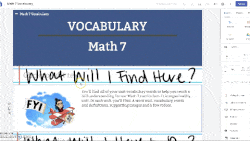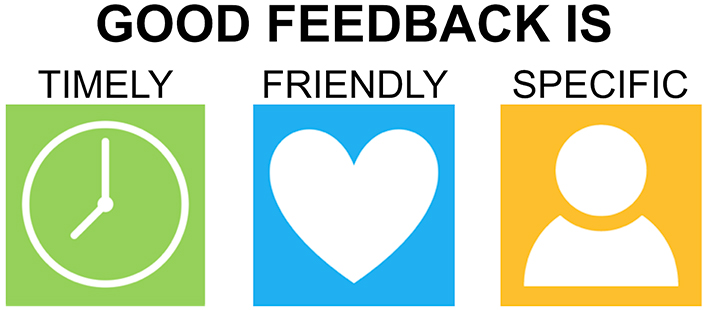Effective feedback looks different when provided online, but it is just as important for student learning.

This article is part of a series about incorporating asynchronous video into educational activities:
- Unbounded by Time: Understanding How Asynchronous Video Can Be Critical to Learning Success
- Putting Your Best Self Forward: 6 Keys For Filming Quality Videos
- Teacher, Are You There? Being "Present" in Online Learning
- Let's Discuss Discussions: Using Asynchronous Video to Improve Online Discussions
- Improving Problem-Based Learning with Asynchronous Video
- Back to Feedback Basics Using Video Recordings
- The Handoff: Transitioning from Synchronous to Asynchronous Teaching
Feedback is critical to students' learning. In fact, John Hattie's seminal research found that providing feedback is one of the most powerful things instructors can do to impact student learning.Footnote1 Feedback has always been a part of teaching and learning, but the internet has dramatically changed how students demonstrate their learning and how instructors provide them with useful feedback. Although text feedback is still the most common form in our digital world, instructors are increasingly providing their students with video-recorded feedback messages—for good reason.
Types of Feedback Videos
You can provide video feedback to students in three ways: (1) webcam video, (2) screen recording, and (3) screen recording with webcam video (see figure 1).
-
Webcam Only

-
Screen Recording Only

-
Screen Recording with Webcam

Figure 1. Three types of video feedback
Each type of video feedback can be used for different purposes.
- Webcam videos are appropriate when you are providing feedback that doesn't require you to show student work. By only showing your webcam video, you can help students form a sense of connection with you and know that your goal is to facilitate their learning.
- Screen recording videos are appropriate when you need to show and verbally describe specific aspects of students work. For instance, if a student created a project, such as a website, image, or document, showing specific parts of the project as you are giving feedback—as seen in figure 1—can be an effective way to provide feedback. In these videos, students can see their work and hear the instructor's voice but can't actually see the instructor speaking.
- Screen recording with webcam videos combine the best of both worlds by placing a small webcam video within the screen recording video. With most tools, however, the webcam video is fairly small, so it can be difficult for students to connect with you, if that is your purpose. Furthermore, if you are not careful, the webcam video can cover up portions of the screen that you are trying to describe. Some tools allow you to change the size and location of the webcam or even remove it completely.
Regardless of the type of video that teachers use to provide feedback, the nature of recording a video allows them to provide more information to students. However, simply providing more feedback is unlikely to benefit students unless it is also quality feedback.
Quality Feedback, and How Video Can Help
Considering the amount of time instructors spend providing feedback, the topic is surprisingly under-researched. I echo Michael Eraut, who said "We need more feedback on feedback."Footnote2 When reviewing the research on feedback, my co-authors and I identified three elements of quality feedback.Footnote3 Specifically, quality feedback should be timely, friendly, and specific (see figure 2).

Using Video to Provide Feedback That Is Specific and Timely
The primary purpose of feedback is to improve student performance. However, not only should feedback highlight what students need to improve and how to improve it, but it should also affirm to students the specific strengths of their work. It's highly important that feedback comments be grounded in a student's actual performance. If not, it can harm their learning. For instance, if a student did poorly on an assignment but then got a "Great work!" comment, this feedback could reinforce low effort or poor performance, as seen in the following clip from the sitcom "Friends" when Joey was trying to learn French.
Providing feedback takes time. As a result, giving students comments that are both timely and specific can be a challenge. Too often teachers either provide quick, generic feedback or provide feedback that is specific but not timely. Having to pick one over the other can be frustrating for teachers. Furthermore, even when instructors take the time to review students' work thoroughly, if they only provide students with scores on a rubric and/or generic-sounding comments, students may question whether the instructors really reviewed their work at all, as in the video below.
Teachers increasingly provide students with feedback via video in an attempt to give more-detailed comments that are rooted in students' specific work. Video comments can also be quicker than providing text feedback when the feedback needs to be detailed and unique to the student (i.e., when copying and pasting text comments would not work). Greg Grimsby at George Mason University provided the video feedback below, which shows feedback on a student's animation—this is a good example of the value of this kind of feedback. As you watch the video, imagine how difficult it would have been to give that level of detail in text.
One drawback of providing feedback by video is that students might find it more difficult to refer back to specific parts of the feedback. This is especially important when students are asked to go back to their project and make revisions based on instructor feedback. In other cases, it just makes more sense to provide feedback in text. For instance, if an instructor is reading a student's essay and needs the student to add a comma in a sentence, the student does not need a video explaining that. As a result, in many cases we recommend that instructors provide feedback using some combination of text and video. For instance, if a student has submitted an essay in a word processing document, the teacher can track edits directly within the document but then provide a video feedback comment describing the overall strengths and areas that can be improved. Similarly, as you review students' work, you might jot down notes on what you would like to highlight in your video comment. If these comments are typed on your computer, you can easily send them to the student with a video comment that elaborates on those points.
Providing Friendly Feedback
Even though your feedback will likely correct students' work, it should be delivered in a friendly manner that strengthens rather than harms the instructor–student relationship. One drawback of text is that the recipient can misinterpret the meaning behind the message. In video, the instructor can communicate using facial expressions and body language that remove much of the ambiguity present in text-only messages. That said, if the instructor is trying to hide frustration or displeasure, text is a better choice because in a video, the student will see the frustration all over the instructor's face. Sometimes ending a sentence with an exclamation mark is easier than showing actual excitement.
In an online learning environment, friendly feedback is a great way to build relationships with others. In the following video you can see how Christine McLaughlin, a sixth-grade teacher, used video to correct her math students' pronunciation. The students had been posting videos defining various math vocabulary, and several had mispronounced the term "finite." She was kind in her correction while also showing her students a little bit of her world. It is a simple example but shows how video can be used to provide correction gently and in a way that strengthens the instructor–student relationship.
Video alone isn't enough to make our feedback friendly. We also need to structure what we say in a way that balances the praise with the critiques while still being social and friendly. One approach to ensure that your feedback is balanced and friendly is to apply the Feedback Cheeseburger. Notice that we added steam coming off the burger to emphasize that feedback burgers should be served quickly, while they are still fresh.

The following video is an example of a feedback comment that followed the model of the Feedback Cheeseburger. Notice that this video features Christine McLaughlin, the same teacher who provided the webcam video comment above. In this case she chose to provide feedback as a screen recording because she needed to highlight specific portions of the students' website.
Conclusion
Regardless of the context, quality feedback should be timely, friendly, and specific. At times this can be especially time consuming to provide online using only text, so we encourage instructors to consider how video messages could improve the feedback that they provide to students. The goal is not to use video feedback for all students on all assignments. Rather, instructors strategically use video when it likely to make the feedback more timely, friendly, and/or specific.
Acknowledgment
This series of articles was written with the support of EdConnect.
Notes
- John Hattie, Visible Learning: A Synthesis of Over 800 Meta-Analyses Relating to Achievement, (New York: Routledge, 2009). Jump back to footnote 1 in the text.
- Michael Eraut, "Feedback," Learning in Health and Social Care 5, no. 3 (September 2006): 111–118. Jump back to footnote 2 in the text.
- Jered Borup, Richard E. West, and Rebecca Arlene Thomas, "The Impact of Text versus Video Communication on Instructor Feedback in Blended Courses," Educational Technology Research and Development 63, no. 2 (April 2015): 161–184. Jump back to footnote 3 in the text.
Jered Borup is an Associate Professor in the Division of Learning Technologies at George Mason University.
© 2021 Jered Borup. The text of this work is licensed under a Creative Commons BY-SA 4.0 International License.
